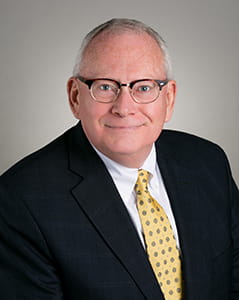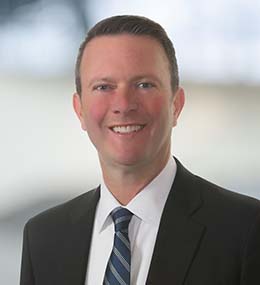Setting the Standard for Intellectual Property
Setting the Standard for Intellectual Property
IP expert and LES (USA & Canada) Chairman-Elect Bill Elkington discusses why IP management and international standardization is critical for business in the 21st century.
 Bill Elkington has more than 30 years of intellectual property (IP) management experience. Throughout his career, he has worked in various capacities involving research and development (R&D), operations, and strategic planning for intellectual assets. As the Senior Director of IP Management at Rockwell Collins, he works among senior leaders overseeing IP asset management, IP process and policy, and transaction support with government entities. Elkington also serves in leadership roles for the Licensing Executives Society (USA & Canada) (LES), where he has been leading the charge for IP standards. On behalf of the Stout Journal, Stout Managing Directors David Haas and Scott Weingust recently spoke with Elkington, who detailed the IP practice at Rockwell Collins, the reasons for and the objectives of the LES Standards Initiative, and how businesses should establish IP management departments, similar to human resources.
Bill Elkington has more than 30 years of intellectual property (IP) management experience. Throughout his career, he has worked in various capacities involving research and development (R&D), operations, and strategic planning for intellectual assets. As the Senior Director of IP Management at Rockwell Collins, he works among senior leaders overseeing IP asset management, IP process and policy, and transaction support with government entities. Elkington also serves in leadership roles for the Licensing Executives Society (USA & Canada) (LES), where he has been leading the charge for IP standards. On behalf of the Stout Journal, Stout Managing Directors David Haas and Scott Weingust recently spoke with Elkington, who detailed the IP practice at Rockwell Collins, the reasons for and the objectives of the LES Standards Initiative, and how businesses should establish IP management departments, similar to human resources.
The Journal: Thank you for joining us, Bill. We would like to introduce you to our readers. Maybe you could start by telling us where you grew up?
Bill Elkington: I grew up in southeast Michigan in the suburbs of Detroit; Birmingham specifically.
The Journal: In your childhood, were there any signs that would have predicted an interest in intellectual property?
Elkington: I think so. In Dearborn, MI, just outside Detroit, there are a couple of super resources called the Henry Ford Museum of American Innovation and Greenfield Village, which is an area laid out like a late 19th century or early 20th century village. It had a replica of Thomas Edison's lab in Menlo Park, NJ, the Wright Brothers' restored bicycle shop and home, which had been moved there from Dayton, OH, a replica of one of the early Ford plants in the Detroit area, and other inventive facilities of note.
Visitors would wander through the village. There were actors playing parts. And there were artifacts in these replica and restored buildings. You felt like you were stepping back to the time that Thomas Edison was inventing the lightbulb. I visited these places numerous times as a child and really got immersed in the culture of innovation. I became fascinated with invention and came to hold inventors in the highest esteem, as a result of these often-repeated immersions in the world Henry Ford had created in Greenfield Village.
The Journal: How did you get involved in IP, and what are some of the more interesting roles that you've had throughout your career?
Elkington: My first employer was an electronics lab, and I was involved in R&D projects related to new business opportunities. At that organization, we chased technology-development contracts with the U.S. government labs. I was the liaison between the project teams and the patent attorney, and so that was my earliest exposure to actually doing work in the field. That was back in the early '80s.
I've had a number of roles since then – strategic planning roles, operations planning roles. The most interesting roles had to do with being a business developer and program manager on Defense Advanced Research Projects Agency (DARPA) contracts. One memorable project was called Aladdin – a gigaflop in a soupcan. At the time, it was the densest parallel-processing floating-point computer in the world.
I was also a program manager on a DARPA program for mesh-networking systems. I ultimately licensed that mesh-networking technology from my employer to a startup company, and then I joined the startup company as a Co‑Founder and Vice President of program management.
The Journal: We understand that you're currently the Senior Director of IP Management at Rockwell Collins. Can you tell us a little bit about the company?
Elkington: First of all, Rockwell Collins is the best company I have ever worked for. It is really well-managed and has a stellar track record of innovation in its technologies and markets. It is a company that historically has been focused on avionics and communication systems, both for commercial and military applications.
We have had a couple of significant acquisitions over the last few years, one of which was ARINC about three years ago. ARINC brought to Rockwell Collins a strong presence in information services to the aviation industry. We just completed a purchase of B/E Aerospace, which is now called Interior Systems. B/E Aerospace is one of the world leaders in interior systems of commercial aircraft, providing seats, lighting, oxygen systems, bathrooms, and galleys.
The Journal: What are the primary issues and functions that your IP management team addresses for the company?
Elkington: We have responsibilities for IP policy and processes, both on the IP protection side and on the value extraction side of IP transactions.
On the protection side, it is the management and handling of intellectual assets. We are also responsible for looking outward to industry relationships and interactions with Congress and regulatory agencies. So we work on both internally focused policy and process and externally oriented policy.
The Journal: What are your personal responsibilities as the Senior Director of IP Management?
Elkington: I report to the Senior Vice President of Corporate Development. So my colleagues here are the Vice President of Mergers and Acquisitions, the Vice President of Investor Relations, the Senior Director of Enterprise Communications, and the Senior Director of Corporate Strategy.
I have a team of business people who support transactions, both licensing-out and licensing-in. And I have personal responsibility for the external policy work that we do in certain areas with Congress and with the Department of Defense (DOD).
The Journal: What are some of Rockwell Collins' primary IP challenges?
Elkington: Like most companies in the 21st century innovation economy, we have to reeducate people. As [tech innovator] Marc Andreessen pointed out several years ago in a blog, software is eating the modern corporation, and I think we see that in our industry, as well. Software is where the growing focus is in terms of managing IP value and in terms of providing value to customers and other business partners. So helping people manage through this transition into a software and information services world, and helping people think through the IP implications and the value implications around IP, is a big part of what we do.
My team is a business consulting group that advises the company’s business units. The challenge is to keep up with the pace of change and help fill in the IP gaps for our business leaders.
The Journal: Do you agree that in the current environment, it has become more difficult to obtain software patents? And if so, how does that impact your ability to protect and enforce your rights as you are moving more toward a software‑based platform for your technology development?
Elkington: Yes, there have certainly been some changes in the law over the last half-dozen years or so that have significantly affected the efficacy of patents to protect software innovation. But I would point out that in our industry, patents are less important than copyrights and trade secrets.
Aerospace and defense tends to be an industry where there is not much patent litigation, at least up until recently. So patents have not been as prominent a part of our business as you might find in the telecommunications and computing industries.
The Journal: In many companies, IP management is run by attorneys in the legal department without a dedicated IP management business team. How does Rockwell Collins organize its IP management group?
Elkington: I chair the Strategic IP Council (SIPC), which is basically the patent committee for the company. So there is sort of an intersection between my function and the legal function. I work shoulder to shoulder with the people in our office of general counsel. But there are additional structures throughout the company that are focused on IP management.
Working with the SIPC, we have distributed groups of people that we call “IP Steering Teams.” They are allocated a certain number of potential patent applications or “billets” by the SIPC. But we also have a structure made up of the vice presidents – all the senior leaders in our engineering organizations throughout the company – and they lead an effort to develop a strategic plan around the technology development that they will focus on in their organizations to support their businesses.
And there are cross‑enterprise teams of engineers and architects that reconcile the different technical activities and R&D activities that are going on throughout the company to make sure that we are cooperating across organizational boundaries.
We also have a cybersecurity council and a procurement organization that works with suppliers. We have a contracts organization that works with customers. So we have a bunch of structures distributed throughout the company to manage, protect, and extract value from innovation.
The Journal: A lot of companies are struggling to figure out how to best organize and bring resources together to manage IP. Are there any best practices as to how to organize IP management programs to increase effectiveness?
Elkington: My theory is that IP management is similar to human resource management, or will be similar to it as we move further into the 21st century. People will come to the conclusion that there are sets of policies, practices, organizational structures, dashboards, education programs, rewards, and a variety of other things to help orient people around the effective and efficient management of the intellectual capital of a company, just as we have around the human resources of the company.
So you have a human resources organization that sets policy that provides: business relationship managers, consulting and assistance on hiring, and advice on how to incentivize employees and how to get high levels of employee engagement.
And so, too, you can come up with similar programs, policies, and processes around intellectual capital management to maximize the value of the existing intellectual assets created by the company.
I see enterprises moving in that direction because intellectual capital is a huge percentage of the equity value of the enterprise today.
The Journal: You are the Chairman-Elect of the Licensing Executives Society (USA & Canada). Can you tell us about the organization and your current and past roles?
Elkington: LES (USA & Canada) has been around for more than half a century. It was started by people principally interested in patent licensing, both from operating companies and from law firms. Quickly it evolved into a broader-based licensing-focused professional organization with many more enterprises such as consulting companies, valuation companies, brokerage firms, universities, and so on.
Of the IP‑oriented professional associations, LES is best known for its business focus, as opposed to the legal focus of the American Intellectual Property Law Association (AIPLA) or the lobbying focus of the Intellectual Property Owners Association (IPO). I have been a member of LES, on and off, since 1992, and a steady member since 2003. I have been on the board of directors for half-dozen years. During this time, I have been Chair of an invitation‑only conference that LES puts on called the LES IP100 Executive Forum.
I have been Vice President of Membership and Vice President of Communications, and I am currently a leader of the LES Standards Initiative.
The Journal: What is the LES Standards Initiative?
Elkington: This idea evolved out of an LES board dinner three-and-a-half years ago at the LES Annual Meeting in Philadelphia.
There are dozens, if not hundreds, of best practices books and certainly hundreds of articles on what are purported to be best practices in IP management. But when you look at them side by side, you discover that one person's best practices are not another person's best practices. So we are not speaking with one voice as a profession. Thus, we discussed what we could do differently or better to help the profession and help the economy.
We came up with the idea of standards. And when we say standards, I think of an example like the ISO 9001 quality standard. It is a business process standard that has been in place in various forms for quite a long time. It was developed by the British Standards Institute initially and then handed off to the International Organization for Standardization (ISO) to manage and take forward. It has become a rather large family of standards around quality management throughout an enterprise. We thought a similar concept would be beneficial in the field of IP management.
We want people to understand that we're going to do this in an above‑board, open, balanced, process-driven way. And the way to assure people of that is to become accredited by the American National Standards Institute (ANSI), which is the accrediting organization for voluntary consensus standards developers in the United States. LES became accredited in February 2017.
The Journal: What are the objectives of the Standards Initiative?
Elkington: There are four principal objectives for the initiative. The first is to raise the standards of business conduct in IP-oriented transactions. The second is to improve the practice of IP management and, by doing so, to mitigate its risks. The third is to reduce the cost and time required to execute IP-oriented transactions and to manage IP generally. And the fourth is to protect and preserve the value of IP.
The general goal of all of these is to encourage investment in innovation and enhance the economic well‑being of society.
There are currently five active committees: IP valuation; IP licensing; IP brokerage; intellectual assets in the board room, which has to do with what boards should do in order to perform their oversight function with respect to intellectual asset management; and IP protection in the supply chain.
There are three additional committees that we're considering: IP hygiene for startups – to help startups figure out the checklist of things that they need to be doing in order to responsibly manage their IP assets; reasonable and nondiscriminatory/fair, reasonable, and nondiscriminatory (RAND/FRAND) licensing standards; and patent quality.
The Journal: Are you working with other IP organizations to advance these initiatives, as well?
Elkington: Yes. We have representatives from AIPLA and from the American Bar Association’s (ABA) IP Section working with us on these standards committees. And we have reached out to IPO, as well.
We have also reached out to several governmental regulatory organizations. There is an executive order (OMB Circular A-119) that directs government agencies to prefer voluntary consensus standards over unique government regulatory standards. So there is a motivation for regulatory folks to get involved with voluntary consensus standards, and, of course, we would recommend that they consider getting involved in the development of LES’ IP management standards.
The Journal: If our readers are interested in supporting or joining the Standards Initiative, what would be the best ways that they could act or voice their support?
Elkington: They could become members of the LES Standards Initiative and participate in the committees, or they could participate as a commenter and voter once the draft standards come out of committee and get submitted to ANSI.
There is a web page on the LES website devoted to LES Standards, and there is a link on that page to enroll in either of these capacities that I have just described. [See http://www.lesusacanada.org/?lesstandards]
The Journal: We understand that you are a member of a government-industry panel called the Section 813 Panel. This panel meets at the Pentagon every few weeks and studies the IP laws and regulations pertaining to IP rights in relation to DOD acquisitions. Can you tell us about the panel, including why it was developed and what its purpose is?
Elkington: Every year Congress passes what is called the National Defense Authorization Act (NDAA). It is basically the DOD budget for the year with any additional guidance from Congress to the department. In the 2016 NDAA, there was a requirement for the development of this panel to study law and regulation around IP rights in defense acquisitions.
There is a perception that the edge the DOD has had globally has historically been associated with innovation and advanced technology. And what policy makers within the government have been saying for a while is that, for some reason, they are not seeing the level of investment in innovation these days that they have seen in the past by traditional suppliers to the DOD. And they are not seeing as much interest as they would like to see on the part of many commercial and consumer-oriented high-technology companies in doing business with the DOD.
Part of the hypothesis has been that this lack of investment, or lack of interest in doing business with the DOD by advanced-technology companies, is that the laws and regulations around IP rights when the department attempts to buy goods and services from private companies may deter those companies. So the idea was: Let us figure out what we need to change about the law and the regulation to persuade people to invest at the rates that they used to and to persuade both commercial companies and traditional DOD suppliers to make the fruits of their R&D available to the DOD for its purposes.
The Journal: Is there any way to bring together the work that is being done at LES relating to standards and the issues that are being addressed by the Section 813 Panel?
Elkington: Yes. In fact, some of the companies that I work with on the Section 813 Panel are also involved in LES Standards. And they are involved because we think that standards can be an effective way of helping both the DOD and the companies that sell products and services to the department, to develop a common language about how to do these IP transactions. The idea is to find a way to balance the needs of the parties.
One of the characteristics of the DOD is that it has significant market power. You might say the same thing about a number of the high‑technology firms that it wants to work with. So this is an attempt to break through that dynamic in the context of IP transactions and try to establish a foundation for executing those transactions without a lot of perceived risk and concern over the possibility of disputes.
The Journal: What are your opinions of the current state of IP in the U.S. and the world, and how do you see things changing in the future?
Elkington: The prior Premier of China – Wen Jiabao – famously said, “The future competition in the world is about intellectual property.” And this was back in 2004. Like him, I really believe that competitive advantage and value is being driven by innovation and the intellectual assets that are the fruits of innovation.
I see us becoming more and more cognizant of that globally, more attuned as to how to manage these assets well, and more motivated by our constituencies to do this well.
We are basically a global economy now. Most companies like Rockwell Collins have global customers. A good percentage of our business is in selling products and services across borders. And our supply chains are global. So it makes sense that we ought to be sorting this out globally and working toward a way to get IP management out of the courtroom and into business processes.
Several major constituencies – Congress, judges, juries, and regulators – are really removed from intellectual asset management. They don't know very well what works and what's best. We ought to be actually turning to the people who do this for a living to help us get this right.
I think that is the direction that we need to go globally. The LES Standards are meant to be globally applicable standards, and we welcome participation from enterprises all over the world.
Professionisti correlati
Approfondimenti correlati
-

Articolo
Where We've Come From and Where We're Going With Intellectual Property
-

Commento
Giving Up Control Self-Driving Cars and Intellectual Property
-

Articolo
Artificial Intelligence: Does It Work for Patent Valuation?
-

Articolo
Measuring the Mark: Use of Analytics in Trademark Infringement Cases
-

Articolo
Tricks of the Trade(mark): An Introduction to Trademark Valuation




